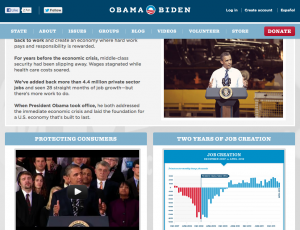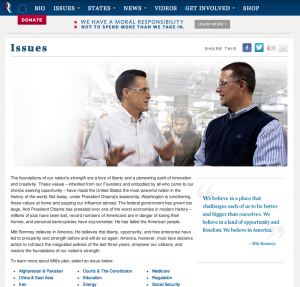Brands
Content Campaign ’12: How the Obama and Romney Websites Stack Up
As part of the Content Campaign ’12 Series, The Content Strategist examines the content published by the presidential campaigns as part of their strategy to win November’s general election.
President Barack Obama’s 2008 online strategy forever changed political campaigns. The ways politicians communicate with the public in the digital arena are now integral to attaining the Oval Office.
 Not surprisingly, Obama and Republican challenger Mitt Romney are in a content strategy arms race, with each technological development upping the political ante and raising the campaign price tag (this is already the most expensive election).
Not surprisingly, Obama and Republican challenger Mitt Romney are in a content strategy arms race, with each technological development upping the political ante and raising the campaign price tag (this is already the most expensive election).
 In the months approaching the 2012 presidential election, The Content Strategist will examine the contenders’ campaigns through their content strategy. This week, we take a first look at their main source of content: their websites.
In the months approaching the 2012 presidential election, The Content Strategist will examine the contenders’ campaigns through their content strategy. This week, we take a first look at their main source of content: their websites.
Getting the message through
According to Colleen Jones, author of Clout: The Art and Science of Influential Web Content, a book featuring case studies of Obama’s 2008 grassroots campaign, Barack Obama and crew are sticking to what worked last time. This involves doing much of the innovation in-house and galvanizing an audience they already have.
 “They’ve done a really good job of providing content that gets people to take action,” Jones said, referring to the simple volunteer registry and the multiple donation options like “quick donate $5” and cash gifts for Obama’s birthday—located front and center at barackobama.com.
“They’ve done a really good job of providing content that gets people to take action,” Jones said, referring to the simple volunteer registry and the multiple donation options like “quick donate $5” and cash gifts for Obama’s birthday—located front and center at barackobama.com.
But such efforts appeal mainly to those who are already voting for Obama. How does a candidate influence people who are on the fence?
The answer: Content strategy.
At its base, content strategy is about defining a message and backing it up. On his website, Obama defines his message as “Forward,” but what that actually means is vague.
According to Kristina Halvorson, CEO of content strategy consultancy Brain Traffic, “On the homepage we don’t need to see Barack’s birthday right up front,” she said. “As a campaign tactic, we want something hard-hitting. There’s work to be done and we need to know about it.”
To make “Forward” a meaningful direction, Obama needs to sum up what that means right away, whereas now much of that content is buried in the website, in places users have to scroll down to or click on to see.
 Mitt Romney‘s campaign also seems to be following Obama’s 2008 paradigm with what is basically a 24-hour publicity channel. On his website, Romney is much more successful when it comes to quickly conveying and bulwarking his message of fiscal responsibility.
Mitt Romney‘s campaign also seems to be following Obama’s 2008 paradigm with what is basically a 24-hour publicity channel. On his website, Romney is much more successful when it comes to quickly conveying and bulwarking his message of fiscal responsibility.
At top of the homepage, it says: “We have a moral responsibility not to spend more than we take in.” Directly below that are a rotation of four articles, two of which currently have to do with the economy.
The donation button is secondary but, as a challenger, Romney has more of a burden convincing people to vote for him, let alone donate to him.
Setting the content agenda
The meat and potatoes of any political election are the candidates’ issues. Both Obama and Romney lay out their issues on tabs on their websites, but both have flaws in the way they present their information.
 Obama’s issue pages feature quick summations of the issues, paired with related multimedia, infographics and video. The downside to this brevity is that the content can seem disjointed.
Obama’s issue pages feature quick summations of the issues, paired with related multimedia, infographics and video. The downside to this brevity is that the content can seem disjointed.
Under “jobs and economic growth,” for example, Obama starts with a series of bullet points.
But statements such as “When President Obama took office, he both addressed the immediate economic crisis and laid the foundation for a U.S. economy that’s built to last” don’t really satisfy people who might be skeptical of such a claim.
 Most of Romney’s issues on the other hand have his main points buried in a sea of text that can’t be read quickly or easily. This means readers must dig for answers, which they are not likely to do.
Most of Romney’s issues on the other hand have his main points buried in a sea of text that can’t be read quickly or easily. This means readers must dig for answers, which they are not likely to do.
Jones said what would be best content-wise is a combination of both Obama and Romney’s issue strategies.
“The idea would be incorporate both: the cohesive design of Obama’s, which includes video and infographics, with an editorial commentary approach and point of view of the Romney campaign,” Jones said.
That way readers could quickly get the information they’re looking for: information that is substantive and clear.
Get better at your job right now.
Read our monthly newsletter to master content marketing. It’s made for marketers, creators, and everyone in between.




